Small overlap front: driver-side
Rating applies to 2008-13 models
Tested vehicle: 2012 Nissan Rogue S 4-door 4wd
The Nissan Rogue was introduced in the 2008 model year. The vehicle was renamed the Rogue Select in the 2014 model year to distinguish it from the redesigned 2014 Rogue. The Rogue Select is less expensive and shares no ratings with 2014 and later models of the Rogue.
| Overall evaluation | |
|---|---|
| Structure and safety cage | |
| Driver injury measures | |
| Head/neck | |
| Chest | |
| Hip/thigh | |
| Lower leg/foot | |
| Driver restraints and dummy kinematics The dummy’s head contacted the frontal airbag but slid off the left side, leaving the head vulnerable to contact with forward structure. The steering column moved 15 cm to the right as well as 15 cm upward, contributing to inadequate protection for the head and allowing little airbag cushioning for the chest. The side curtain airbag deployed and had sufficient forward coverage to protect the head from contact with side structure and outside objects. The side torso airbag also deployed. |

Action shot taken during the small overlap frontal crash test.

The dummy's position in relation to the door frame, steering wheel, and instrument panel after the crash test indicates that the driver's survival space wasn't maintained well.
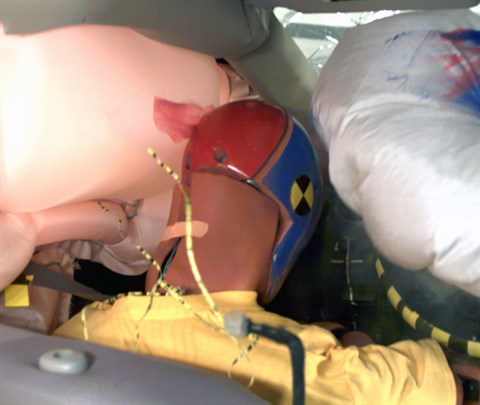
The dummy’s head contacted the frontal airbag but then slid off the left side as the steering column moved upward and to the right. The side curtain airbag extended far enough forward toward the A-pillar to protect the head from contact with forward side structure.
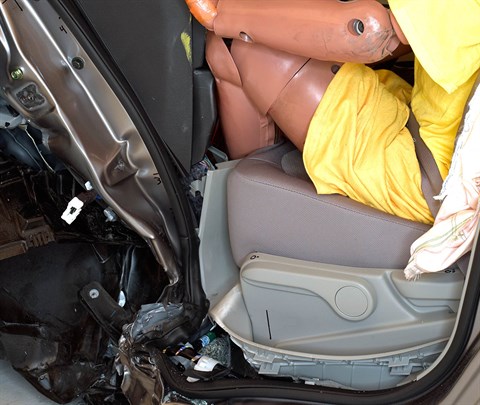
Door hinge pillar and instrument panel intrusion was extensive and contributed to a significant risk of injury to the left lower leg and a moderate risk to the left foot.
Measures of occupant compartment intrusion on driver side
| Test ID | CEN1224 |
|---|---|
| Lower occupant compartment | |
| Lower hinge pillar max (cm) | 38 |
| Footrest (cm) | 24 |
| Left toepan (cm) | 13 |
| Brake pedal (cm) | 5 |
| Parking brake (cm) | 18 |
| Rocker panel lateral average (cm) | 6 |
| Upper occupant compartment | |
| Steering column | 6 |
| Upper hinge pillar max (cm) | 22 |
| Upper dash (cm) | 24 |
| Lower instrument panel (cm) | 27 |
Driver injury measures
| Test ID | CEN1224 |
|---|---|
| Head | |
| HIC-15 | 82 |
| Peak gs at hard contact | no contact |
| Neck | |
| Tension (kN) | 0.9 |
| Extension bending moment (Nm) | 10 |
| Maximum Nij | 0.16 |
| Chest maximum compression (mm) | 24 |
| Femur (kN) | |
| Left | 3.2 |
| Right | 1.0 |
| Knee displacement (mm) | |
| Left | 9 |
| Right | 2 |
| Knee-thigh-hip injury risk (%) | |
| Left | 1 |
| Right | 0 |
| Maximum tibia index | |
| Left | 1.15 |
| Right | 0.41 |
| Tibia axial force (kN) | |
| Left | 4.0 |
| Right | 0.6 |
| Foot acceleration (g) | |
| Left | 153 |
| Right | 40 |
Moderate overlap front: original test
Rating applies to 2008-13 models
Tested vehicle: 2008 Nissan Rogue S 4-door 4wd
The Nissan Rogue was introduced in the 2008 model year. The vehicle was renamed the Rogue Select in the 2014 model year to distinguish it from the redesigned 2014 Rogue. The Rogue Select is less expensive and shares no ratings with the 2014 Rogue.
| Overall evaluation | |
|---|---|
| Structure and safety cage | |
| Driver injury measures | |
| Head/neck | |
| Chest | |
| Leg/foot, left | |
| Leg/foot, right | |
| Driver restraints and dummy kinematics |
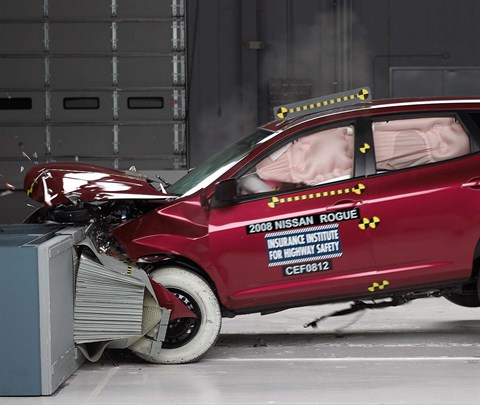
Action shot taken during the frontal offset crash test.

The dummy's position in relation to the steering wheel and instrument panel after the crash test indicates that the driver's survival space was maintained well (dummy's head obscured by deployed side curtain airbag).
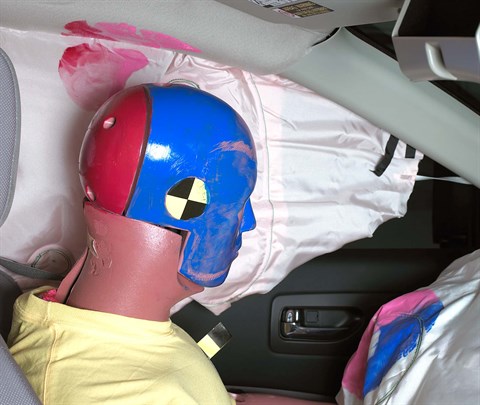
Smeared greasepaint indicates where the dummy's head contacted the side curtain airbag and dislodged headliner during rebound.
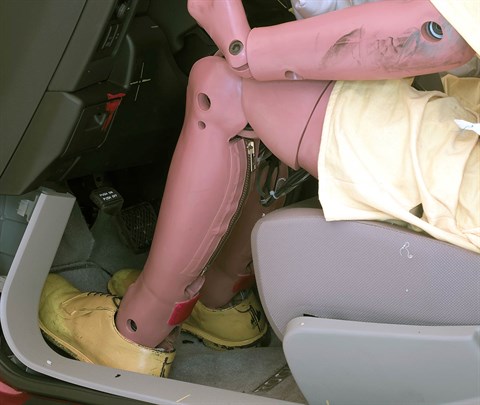
Intrusion into the driver's space was minimal, and all leg and foot injury measures were low.
Measures of occupant compartment intrusion on driver side
| Test ID | CEF0812 |
|---|---|
| Footwell intrusion | |
| Footrest (cm) | 7 |
| Left (cm) | 13 |
| Center (cm) | 7 |
| Right (cm) | 10 |
| Brake pedal (cm) | 8 |
| Instrument panel rearward movement | |
| Left (cm) | 2 |
| Right (cm) | 3 |
| Steering column movement | |
| Upward (cm) | 0 |
| Rearward (cm) | -2 |
| A-pillar rearward movement (cm) | 1 |
Driver injury measures
| Test ID | CEF0812 |
|---|---|
| Head | |
| HIC-15 | 298 |
| Peak gs at hard contact | 73 |
| Neck | |
| Tension (kN) | 1.3 |
| Extension bending moment (Nm) | 25 |
| Maximum Nij | 0.29 |
| Chest maximum compression (mm) | 25 |
| Legs | |
| Femur force - left (kN) | 0.1 |
| Femur force - right (kN) | 0.3 |
| Knee displacement - left (mm) | 0 |
| Knee displacement - right (mm) | 0 |
| Maximum tibia index - left | 0.42 |
| Maximum tibia index - right | 0.42 |
| Tibia axial force - left (kN) | 1.2 |
| Tibia axial force - right (kN) | 1.2 |
| Foot acceleration (g) | |
| Left | 48 |
| Right | 84 |
Side: original test
Rating applies to 2008-13 models
Tested vehicle: 2008 Nissan Rogue S 4-door 4wd with standard front and rear head curtain airbags and standard front seat-mounted torso airbags
The Nissan Rogue was introduced in the 2008 model year. The vehicle was renamed the Rogue Select in the 2014 model year to distinguish it from the redesigned 2014 Rogue. The Rogue Select is less expensive and shares no ratings with 2014 and later models of the Rogue.
| Overall evaluation | |
|---|---|
| Structure and safety cage | |
| Driver injury measures | |
| Head/neck | |
| Torso | |
| Pelvis/leg | |
| Driver head protection | |
| Rear passenger injury measures | |
| Head/neck | |
| Torso | |
| Pelvis/leg | |
| Rear passenger head protection | |
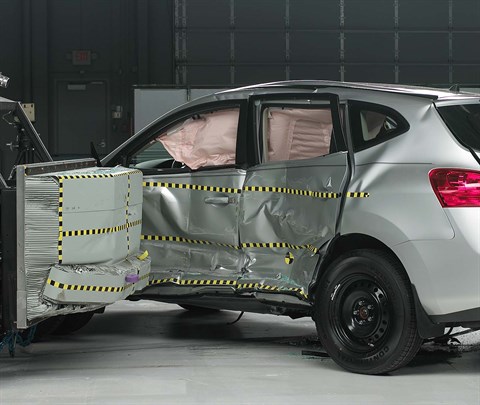
View of the vehicle and barrier just after the crash test.
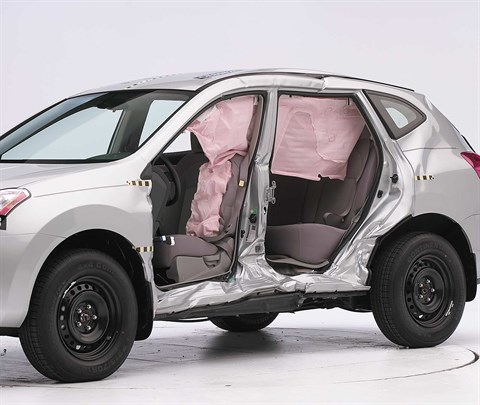
View of the vehicle after the crash with doors removed, showing the side airbags and damage to the occupant compartment.
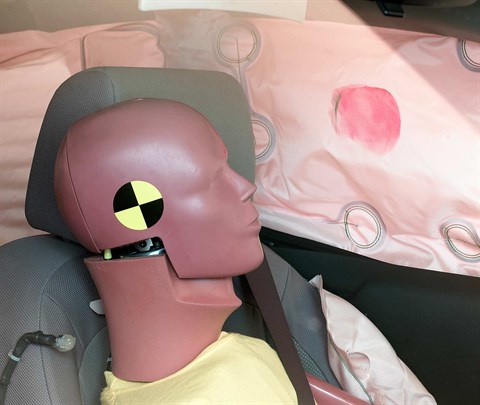
Smeared greasepaint shows where the driver dummy's head was protected from being hit by hard structures by the side curtain airbag.

Smeared greasepaint shows where the rear passenger dummy’s head was protected by the side airbag.
Measures of occupant compartment intrusion on driver side
| Test ID | CES0828 |
|---|---|
| B-pillar to longitudinal centerline of driver's seat (cm) | -12.0 |
| Negative numbers indicate the amount by which the crush stopped short of the seat centerline. | |
Driver injury measures
| Test ID | CES0828 |
|---|---|
| Head HIC-15 | 74 |
| Neck | |
| Tension (kN) | 0.7 |
| Compression (kN) | 0.1 |
| Shoulder | |
| Lateral deflection (mm) | 29 |
| Lateral force (kN) | 1.2 |
| Torso | |
| Maximum deflection (mm) | 23 |
| Average deflection (mm) | 21 |
| Maximum deflection rate (m/s) | 4.04 |
| Maximum viscous criterion (m/s) | 0.30 |
| Pelvis | |
| Iliac force (kN) | 0.7 |
| Acetabulum force (kN) | 2.3 |
| Combined force (kN) | 2.7 |
| Left femur | |
| L-M force (kN) | 0.8 |
| L-M moment (Nm) | 124 |
| A-P moment (Nm) | 34 |
Passenger injury measures
| Test ID | CES0828 |
|---|---|
| Head HIC-15 | 111 |
| Neck | |
| Tension (kN) | 0.0 |
| Compression (kN) | 0.5 |
| Shoulder | |
| Lateral deflection (mm) | 32 |
| Lateral force (kN) | 1.3 |
| Torso | |
| Maximum deflection (mm) | 23 |
| Average deflection (mm) | 17 |
| Maximum deflection rate (m/s) | 2.52 |
| Maximum viscous criterion (m/s) | 0.21 |
| Pelvis | |
| Iliac force (kN) | 0.2 |
| Acetabulum force (kN) | 2.6 |
| Combined force (kN) | 2.6 |
| Left femur | |
| L-M force (kN) | 0.6 |
| L-M moment (Nm) | 51 |
| A-P moment (Nm) | -28 |
Roof strength
Rating applies to 2008-13 models
Tested vehicle: 2009 Nissan Rogue S 4-door 2wd
(Curb weight from 2008 Nissan Rogue S 4-door 4wd)
| Overall evaluation | |
|---|---|
| Curb weight | 3,430 lbs |
| Peak force | 11,460 lbs |
| Strength-to-weight ratio | 3.34 |
Head restraints & seats
Seat type: Manual cloth seats AHR
| Overall evaluation | |
|---|---|
| Dynamic rating | |
| Seat/head restraint geometry |
| Seat type | Manual cloth seats AHR |
|---|---|
| Geometry | |
| Backset (mm) | 32 |
| Distance below top of head (mm) | 42 |
| Seat design parameters | |
| Pass/fail | Pass |
| Max T1 acceleration (g) | 11.6 |
| Head contact time (ms) | 63 |
| Force rating | 1 |
| Neck forces | |
| Max neck shear force (N) | 30 |
| Max neck tension (N) | 596 |
About the head restraint & seat test
Currently, IIHS tests apply only to front seats.
